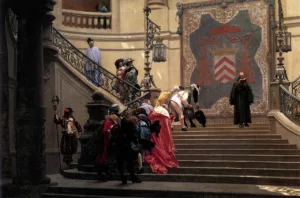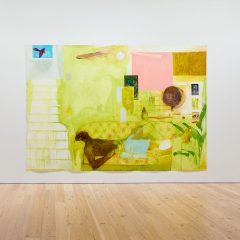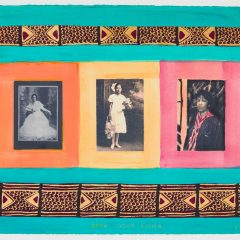Jasper Johns and Antony Gormley have both reached a rare, almost unbelievable degree of fame for living artists, although in two different ways. After five decades of work, Johns, who was once featured as a character in The Simpsons back in the ’90s, seems to be a household name. The cartoon version of Johns was depicted stealing slices of bread, coat hangers, and a lightbulb from an art gallery. Gormley, on the other hand, is mega-famous in the art world only, renowned in the United States and his native U.K for his sculpture work, but otherwise easily reducible to “the guy who makes casts of his body from different materials.”
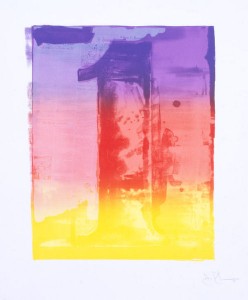
Viewing the work of both artists together at the Phillips Collection (solo exhibits, both up through September 9) is a feast for the senses that’s remarkably spiritually soothing, even as it expands and refines one’s aesthetic perceptions. Or, if you’re just looking to get out of Philly during the dog days of August, a day trip to Washington D.C.’s Dupont Circle neighborhood, where the Phillips is located, feels like a high point in a town already full of great art.
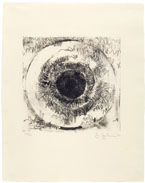
Jasper Johns: Variations on a Theme is a retrospective of Johns’ work in the field of printmaking from 1960 to 2011, including 90 works of lithography, intaglio, silkscreen, and lead relief. The dangling lightbulb that Johns “stole” in The Simpsons is here, as is the coathanger and the slice of bread, variations of the 0-9 (number) series and Johns’ depictions of the American flag.
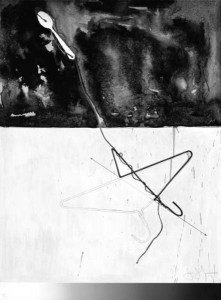
This reviewer experienced the shock of first exposure in the flesh to works that are well-known in reproductions, parody, and imitation. There is that indefinable chill down the spine when you recognize the focus and effort represented by every miniscule shape and oscillation of line, curve, color and stroke in these works. The random shapes of banal objects and the lines they form become miraculous explorations of physicality in Johns’ hands. In “According to What Coathanger and Spoon,” the deriving of line from a bent coathanger is both a fun game inviting random play into the piece and a challenging spatial/geometric exploration.
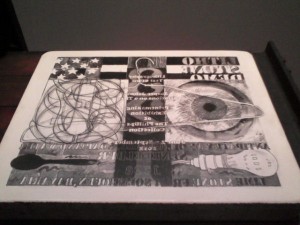
The spiraling complexity of the works over the years, as Johns places his objects amidst more and more complex and colorful new patterns, brings them all together. It makes the earlier work with everyday objects seem more firmly like the early stages and building blocks of a process towards a very American abstraction of common household objects.
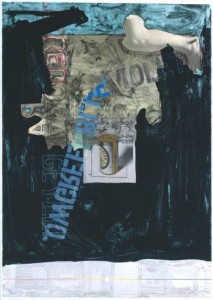
The gallery also includes a small recreation of Johns’ printing press studio, and the documentary film Decoy by Michael Blackwood, which takes us insides Johns’ process. Ultimately, words fail when describing the deep pervading sensibility of colors and lines at play in Johns’ work, but it’s as deeply satisfying of an experience as I’ve had in an art gallery in years.
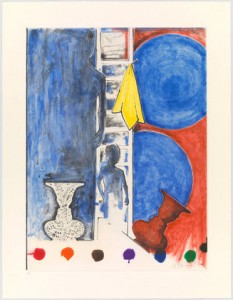
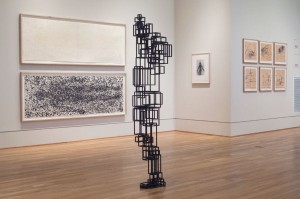
Antony Gormley: Drawing Space displays sculpture and 80 prints and drawings created over 40 years. This is the first U.S. exhibition of Gormley to include his work on paper. And while his sculptures are modeled on his own body, they feel like a universal human figure, each in its form and material representing an entire universe of perception and experience. Contrast the fluctuating sizes of iron squares in “Clasp II” (above) that form one geometric (perhaps right-brained?) figure with the exploding spiky atomic structures and outward projecting physicality of “Aperture XIII,” (below) which greets visitors entering the Phillips’ main hall.
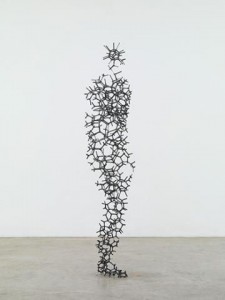
Bearing Light, Antony Gormley’s series of 12 woodblock prints from 1990, is also on display in the Phillips (below). In his works on paper and sculpture, black and white lines come alive and off the paper into the room where the viewer’s standing in an active and actively involving experience. The shape of Gormley’s objects pulses as if alive; they are all harmonized with a similar energy. Knowing Gormley’s more famed sculptures, his successful and diverse work on paper is thrilling as an example of his virtuosity in woodblock printing and drawing.
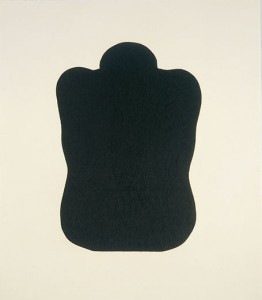
There’s something either spiritual or simply beyond the material plane in the portrayal of fields of energy between shapes, human and inhuman, that questions the dualities of black and white and inanimate and animate. There is a profound reverberation between space and emptiness in all of Gormley’s works on display here. That room for personal introspection when faced with compelling figures and patterns may be what joins Gormley and Johns work: the fact that both artists incite the viewer to intense, frenzied meditation and imagination.
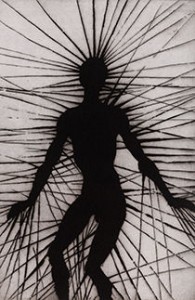
Antony Gormley: Drawing Space and Jasper Johns: Variations on a Theme will be on display at the Phillips Collection through September 9. For more information, visit phillipscollection.org.


